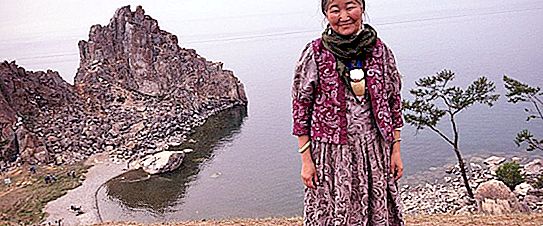Burkhan (aka Cave, Shamansky) is a cape on the western tip of the island of Olkhon, located on Lake Baikal. The cape is crowned by a rock with two peaks, which is called the Shaman-rock. She is also known by other names: stone-temple, rock Shaman, Shaman-stone. The territory of the national park. This formation is recognized as a state natural and historical monument.
Cape Burhan and Shaman Rock
The name "Burkhan", according to historians, was entrenched in the Cape in the seventeenth century, when Buddhism from Tibet came to the Baikal region. He supplanted shamanism. The word "Burkhan" among the Buryat Buddhists meant the name of the main god of Lake Baikal. And the cape and its through cave began to be considered the abode of God.
Unique natural formation
The rock with two peaks is formed by dolomite limestone and marble slabs, among which there are structures with shiny graphite impregnations. It is covered with lichen in bright red shades.
One of the peaks of the cliff, which is closer to the coast, reaches a height of 30 meters. Far 12 meters higher. Closer to the shore in the rock is a through cave, winding in its length, it is called Shaman.
It was formed naturally, due to weathering of limestone rocks. It reaches a length of about twelve meters. The height of the arches is from 1 to 6.5 meters. The width between the walls is from 3 to 4.5 meters. At the entrance to the cave from the western direction there is a platform from which it is convenient to go on the east side of the cliff along a rising passage. In the cave itself there are lateral dead end corridors.

In the western part of the Shaman-rock, on its far side, there are natural outcrops of brown rock, which can be mistaken for a stylized image of a dragon.
Interesting historical information about the Shamanka rock
The first scientific research on Lake Baikal dates back to the 18th-19th centuries. And the researchers noticed that the Buryats inhabiting these places avoid Cape Burkhan and especially the Shamanka cave. They sincerely believed that Lord Olkhon lived there and it was very dangerous to disturb his spirit.
Subsequently, it was established that during the spread of shamanism, it was in these places that a large number of rites were performed, including with sacrifices. After the Buryats changed their faith to Buddhism, an altar was built in the rock of Shamanka to offer prayers to the Buddha. This place became the object of pilgrimage to the lamas of the Transbaikal Territory. Each lama once a year, in winter, was to visit Cape Burhan.
Buryats still sincerely believe that this place can give a miracle. Visiting him, they ask for upholding their honor, and childless families ask children.
Archaeological finds
On Cape Burhan, the rock of Shamanka, as well as in their vicinity, a fair amount of archaeological finds have been discovered. The first serious researcher of these places was the famous Siberian traveler and geographer I.D. Chersky. After him, archaeological research was continued. Traces of the vital activity of people of the Neolithic era are found. The site of ancient people on the site connecting Burkhan with the island has been excavated. Many cave paintings and inscriptions were found. A significant number were found, according to archaeological excavations, artifacts of various historical eras: jade knife and ax; arrowheads, products from gold, bronze, iron, bones; figurines from slate. As well as images of shamans and their tambourines.
Legends and traditions

There are enough various legends and legends about Cape Burkhan. However, they agree on one thing - this is a holy place endowed with strong energy and inexplicable strength.
The most common legends include the legend of the mighty spirit of Lake Baikal - Khan Hute-baaba. He descended from the sky and chose Cape Burhan and the rock Shamanka for his stay. They became his abode on earth, along with other castles in heaven and underground.
From other legends about Khan-guta-baabaia it follows that he was a hermit-sage. At the request of a widow, he came to the Olkhon lake and saved the locals from the evil Mongol deity. After which he settled on Lake Olkhon, becoming the leader of the Transbaikal shamans.
Recently, a myth has appeared that Cape Burkhan and Shamanka Rock are a place where there is a functioning portal to other dimensions. There are no scientific explanations for this. The public portal is presented by amateur photos of Cape Burhan.

Ninth Shrine of Asia
The shaman rock of Cape Burhan is one of the nine shrines of Buddhist Asia. The remaining 8 holy places usually include:
- Mount Kailash - the peak in the mountain range of Gandisyshan (Trans-Himalayas) in the Tibet Autonomous Region of China. Among Hindus, it is considered the habitat of Shiva.
- Shaolin is a world famous monastery. Located in Henan (PRC), in the Songshan Mountains.
- Shwedagon Pagoda - a gilded stupa in the city of Yangon (Myanmar), about 98 meters high. According to legend, it contains relics of four Buddhas.
- Angkor Wat is a huge temple complex located in Cambodia, erected in honor of the god Vishnu.
- Buddha Tooth Temple - located in the city of Kandy (Sri Lanka). It is assumed that the upper left tooth of the Buddha is walled up in the temple.
- Potala Palace - located in Tibet, in the city of Lhasa. Until 1959, it was the residence of the Dalai Lam.
- Chaittiyo Pagoda is a holy place in Myanmar, 5.5 meters high. It stands on top of a stone, which, in turn, balances on a rocky ledge.
- Sigiriya is a ruined ancient fortress with the ruins of a palace in Matala (Sri Lanka).





